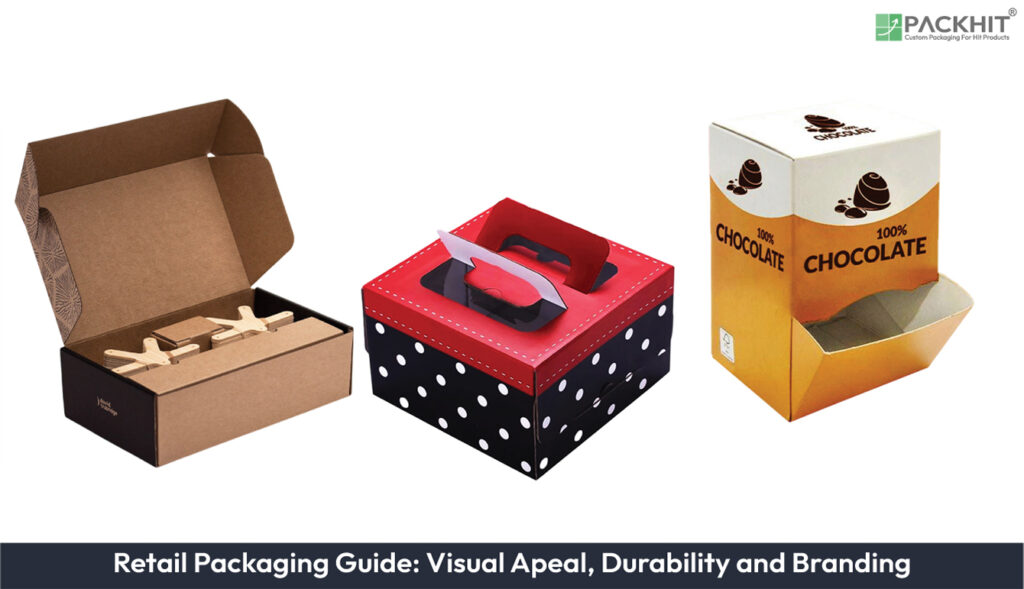Retail packaging encases products for sale, protects them, and communicates brand and product information. It performs five core functions: protection (materials such as corrugated cardboard and coated paperboard), information (ingredients, instructions, barcodes), merchandising (color, shape, finishes), branding (logos, embossing, hot foil stamping), and promotion (QR codes, limited‑edition graphics). Visual design increases shelf visibility and can raise sales by up to 30%. Durability prevents damage during transit and handling; protective features such as inserts, dividers, and tamper‑evident seals secure fragile items, and 58% of shoppers avoid products with damaged packaging. Customization uses digital and offset printing, variable data printing, and unique shapes to support seasonal runs and provide customized protection for sensitive products. Emerging trends favor recyclable, compostable, or biodegradable materials and smart packaging elements such as QR codes and NFC tags that link to recipes or product stories.
What is Retail Packaging?
Retail packaging refers to the materials and designs used to encase and present products for sale in retail settings, such as supermarkets, department stores, and online platforms. It is characterized by its dual purpose: to protect the product and to serve as a marketing tool. Unlike bulk or non-retail packaging, retail packaging prioritizes visual and aesthetic appeal to stand out on shelves and attract consumer attention.
What are the core functions of retail packaging?
Retail packaging performs five core functions: protection, information, merchandising, branding, and promotion.
- Protection: safeguards products from impact, compression, moisture, and abrasion during transportation and handling, using materials such as corrugated cardboard, rigid paperboard, and laminated coatings (examples: single-wall corrugate, coated paperboard).
- Information: displays product facts, instructions, ingredients, regulatory marks, barcodes, and batch/lot codes to guide purchasing and post‑purchase use.
- Merchandising: attracts consumer attention on the shelf through color, shape, printed imagery, and finishes (examples: matte varnish, spot UV) and supports shelf organization and category navigation.
- Branding: communicates logos, taglines, color systems, and tactile cues such as embossing or hot foil stamping to increase brand recognition and consistency.
- Promotion: carries promotional copy, limited‑edition artwork, seasonal graphics, and interactive elements such as QR codes or NFC tags that link to recipes, product stories, or offers.
How Does Visual Appeal Impact Retail Packaging?
Visual appeal is a cornerstone of retail packaging, directly influencing consumer behavior and product visibility. High-quality design elements, such as vibrant colors, unique shapes, and branded graphics, are employed to differentiate products on crowded retail shelves. According to industry data, visually appealing packaging can increase consumer attention and drive sales growth by up to 30% in competitive retail environments.
Aesthetic and Branding Considerations
Retail packaging integrates aesthetic elements to enhance the perceived value of products. Features such as embossing, hot foil stamping, and custom-printed designs contribute to a premium look and feel. Branding elements, including logos, taglines, and consistent color schemes, reinforce brand identity and foster consumer trust. For example, luxury goods often utilize rigid boxes with matte finishes to convey exclusivity and quality.
What Role Does Durability Play in Retail Packaging?
Durability is essential for maintaining product integrity and brand reputation. Retail packaging must withstand various stressors, including transportation, storage, and consumer handling. Materials such as corrugated cardboard, rigid paperboard, and laminated coatings are commonly used to enhance structural strength and resistance to wear and tear.
Protective Features
Effective retail packaging incorporates protective features to prevent damage. For instance, inserts and dividers are used to secure fragile items, while tamper-evident seals ensure product safety. According to a consumer behavior study, 58% of shoppers avoid purchasing products with damaged packaging, underscoring the importance of durability in retail settings.
How Does Customizability Enhance Retail Packaging?
Customizability allows businesses to tailor retail packaging to align with their branding and target audience. Custom-printed packaging designs, unique shapes, and specialized finishes enable brands to create a distinctive market presence. This flexibility is particularly valuable for seasonal promotions, limited-edition products, and personalized gifting.
Technological Advancements in Customization
Advances in printing technologies, such as digital and offset printing, have expanded the possibilities for retail packaging customization. Techniques like variable data printing allow for individualized designs, while sustainable inks and materials align with eco-conscious consumer preferences. These innovations not only enhance visual appeal but also contribute to environmental sustainability.
What are the Emerging Trends in Retail Packaging?
Sustainability and eco-friendliness are at the forefront of retail packaging trends. The use of recyclable, compostable, and biodegradable materials is becoming increasingly prevalent as brands respond to consumer demand for environmentally responsible practices. Additionally, minimalistic designs that reduce material usage without compromising functionality are gaining traction.
Integration of Smart Packaging
Smart packaging technologies, such as QR codes and NFC tags, are being integrated into retail packaging to enhance consumer interaction. These features provide access to product information, promotional offers, and brand stories, creating a more engaging shopping experience. For example, QR codes on food packaging can link to recipes or nutritional information, adding value for the consumer.
How Does Retail Packaging Compare to Non-Retail Packaging?
Retail packaging differs from non-retail packaging in its emphasis on aesthetics and consumer engagement. While non-retail packaging focuses primarily on functionality and cost-efficiency, retail packaging prioritizes visual appeal and branding. For instance, e-commerce packaging often uses plain corrugated boxes for shipping, whereas retail packaging employs vibrant designs to attract in-store shoppers.
Key Differences
The primary distinctions between retail and non-retail packaging lie in their materials, design, and purpose. Retail packaging uses high-quality materials and intricate designs to enhance product presentation, while non-retail packaging opts for cost-effective solutions to ensure safe delivery. Additionally, retail packaging often includes detailed product information and branding elements, which are less emphasized in non-retail contexts.

